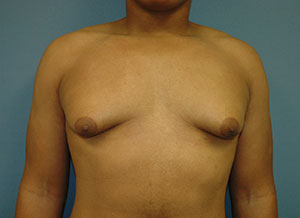Male Breast Reduction (Gynecomastia Surgery)
Gynecomastia is the medical term for abnormally enlarged breasts in a male. This is not uncommon in adolescents, young men, and even older gentlemen. In the younger patient, it can be a great source of embarrassment and social disruption, particularly in the pre-teen and early teenage years and especially with sports-related activities. The condition often diminishes the ability to change in the locker room without undue embarrassment. However, for men of all ages, visible male breast tissue can cause significant psychological distress, diminish self-esteem, and inhibit self-confidence. Male breast reduction is one of our most common male plastic surgery procedures, and is designed to treat gynecomastia by removing excess breast tissue and/or fat in order to restore the appearance of a more flat and typical male chest. Male breast reduction should ideally cause invisible scars, which is why our team takes great care to perform the surgery in a manner that leaves inconspicuous and unnoticeable scarring, usually hidden in the nipple/areola.

Causes of Gynecomastia
While the development of excess breast and/or fatty tissue in the male chest is fairly common, it may occasionally resolve on its own as an adolescent matures through puberty, resulting in a generally normal and flat chest appearance. A number of factors can contribute to enlarged breast tissue in men, including:
- Elevated hormone levels during puberty
- Steroid use
- Obesity
- Medication side effects
- Chronic liver disease
- Hereditary conditions
- Regular use of marijuana
With gynecomastia, it is not uncommon for breast tissue to enlarge asymmetrically; sometimes, excess tissue may even be present in one breast, but not the other. The clinical evaluation of a patient with gynecomastia is usually a thorough medical history and physical examination. In the vast majority of cases, there are no abnormal hormone levels or other endocrine abnormalities to explain the condition. However, genetic influences can also play a role.
True Gynecomastia vs. Pseudogynecomastia
The appearance of excessive male breasts is typically distinguished by either true gynecomastia or pseudogynecomastia, two conditions that are often combined under the general term “gynecomastia.” Since the physical indications of both forms of gynecomastia resemble each other, many patients are unaware which of the two conditions they actually exhibit.
True gynecomastia is the result of excess glandular or breast tissue in the chest, usually with no apparent etiology that can be identified. In contrast, pseudogynecomastia refers to an accumulation of stubborn fat in and around the nipples and breasts, making the male breasts look similar to female breasts. In some cases, pseudogynecomastia can simply be improved by using liposuction to remove the excess fat and decrease an individual’s breast size.
While they may involve different surgical techniques to treat, both sub-types can result in the same symptoms for the patient—namely, self-consciousness and a poor body image. You will be carefully evaluated and the best approach to correct your enlarged breasts will be fully explained.
Male Breast Reduction Procedure
Male breast reduction surgery eliminates excess breast tissue, resulting in a flatter and more normal-appearing male chest. Liposuction is often included to remove excess fat, but abnormal breast tissue cannot be removed via liposuction alone and therefore requires an incision to be placed along the edge of the areola (the pigmented area around the nipple). Your plastic surgeon will discuss the specifics of your treatment plan after a careful consultation and physical examination. When undergoing treatment for gynecomastia, it is not uncommon for men to occasionally combine the procedure with other enhancement options—such as liposuction of the back or flanks—in order to achieve a more attractive outcome overall. Your surgeon will be happy to speak with you about the most ideal options for your ultimate goals.
Male Breast Reduction Recovery
Immediately following surgery, you will most likely wear a support garment for a brief period in order to minimize swelling and promote proper healing of your new chest contour. There will be some degree of normal post-operative bruising and swelling; however, discomfort from this surgery is often minimal and should be manageable with oral pain medication. While strenuous exercise and aerobic activity should be avoided for at least four weeks in most cases, work and other daily activities can usually be resumed within a week. We will give you specific instructions regarding recovery in person.
The results of surgery are typically visible immediately. At approximately six weeks, your fine scars may be a bit pink and itchy, after which they should begin to settle down until they will hopefully be almost invisible by one year after surgery. Men who undergo male breast reduction surgery are usually among the most satisfied individuals at our practice. Gynecomastia patients’ newfound ability to remove their shirt or workout without fear of embarrassment is often life-changing.
Will I Have Scars from Gynecomastia Surgery?
We understand the importance of ensuring that scars from male breast reduction remain as undetectable as possible. Although a scar from any surgical procedure involving incisions is inevitable, gynecomastia surgery from our team is approached very meticulously and all incisions are typically limited to the natural contours around the nipples. Due to the use of skillful technique with regard to incision placement and wound closure, patients generally experience little visible scarring, if any, once fully healed. Proper scar care during the recovery process can allow the best healing of your incisions and increase the likelihood that they fade as time passes.
Can Exercise Be Used to Treat Gynecomastia?
The effectiveness of exercise on male breast enlargement is dependent on the nature of your unique condition. If your gynecomastia is a result of excess glandular breast tissue, exercise will have no effect on the appearance of male breasts. On the other hand, if your gynecomastia is related to obesity, weight loss and exercise can sometimes provide improvement aesthetically; however, it is very rare for gynecomastia to be completely resolved with exercise alone. In most cases, there will be some degree of visible breast tissue, and surgery is the only treatment option to completely remove the excess breast tissue.
Does Male Breast Reduction Result in Excess Skin?
Patients who have good skin elasticity generally don’t worry about excess skin after surgery, as the skin can contract and tighten to their new chest contour. However, for those with poor skin elasticity or a large amount of excess breast tissue, additional procedural steps may be required to remove extra skin during the operation. Your surgeon will perform a thorough examination of your needs and make you fully aware of your surgical expectations during a consultation.
Schedule Your Gynecomastia Treatment Consultation
If you would like more information on the treatment for gynecomastia, or if you would like to schedule a confidential consultation, please contact Plastic Surgery of the Carolinas.

